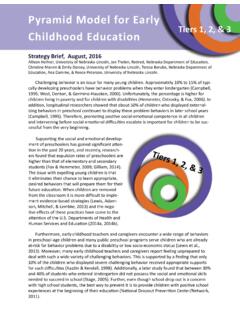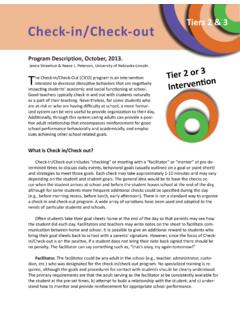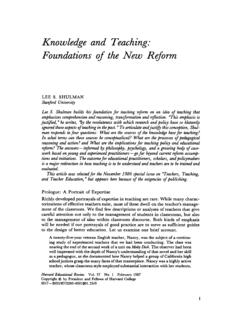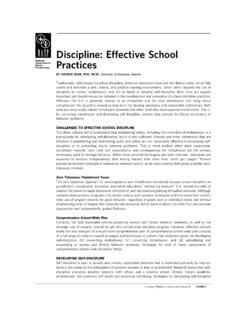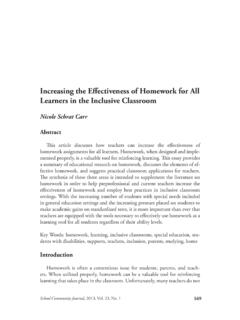Transcription of Resources - Social Skills Curricula & Programs
1 Resources - Social Skills Curricula & ProgramsTiers 1, 2 & 3 Considerations for Choosing and Implementing a Social Skills ProgramWhen considering a Social Skills curriculum or teaching strategies, in addition to age or grade appropriateness, consider whether these issues are addressed (Otten and Tuttle, 2011): Social Skills are often taught through a combination of large group instruction, small skill groups, and individual Social Skills instruction. Does the program or curriculum provide this flexibility? Evidence-based Social Skills Programs will always include direct instruction, modeling, role-playing the skill, practicing the skill in different settings, and performance feedback. Are these types of delivery methods provided or possible? Performance deficits, skill deficits, and fluency deficits need to be determined when choos-ing Social Skills programming. Does the program distinguish these and provide strategies to address each?
2 Self-management without any or minimal cues and prompts is the eventual goal of Social Skills instruction. Does the program lead to effective self-management?Below are examples of well-known readily available, and widely used Social Skills instruction Programs . They are intended to illustrate the types of Curricula and Programs available. Sev-eral of these have been identified as being effective, although the level of research support for effectiveness varies. The Programs also vary in terms of the targeted Skills and intended grade levels included in each curriculum. These Programs are representative examples of the variety of Programs available. No endorsement of specific Programs should be implied. A variety of Social Skills interventions, strategies, and Programs exist to help schools with the task of teaching children and adolescents Social and interpersonal behaviors. Social Skills interventions that incorporate Social and emotional learning Skills have proved to be particularly effective in improving students attitudes towards school, feeling more connected to school, having more positive attitudes towards themselves and others, reducing conduct problems, decreasing emotional distress ( , anxiety, depressive symptoms), and significantly improving academic grades ( , 11 percentile points higher on academic achievement measures; Durlak, Weissberg, Dymnicki, Taylor, & Schellinger, 2011).
3 Nevertheless, there has been some concern about the ability of this type of instruction to generalize to the real life situations where these Skills should be employed. For a more detailed description of Social Skills instruction generally including the purposes, nature, and research see the Strategy Brief on Social Skills Instruction. Resource Brief, September, 2014. Ann O Connor, Jenna Strawhun, Natalie Hoff & Reece L. Peterson, University of - Social Skills Curricula 2 The ACCEPTS Program ACCEPTS (A Curriculum for Children s Effective Peer and Teacher Skills ) is a program for teaching classroom and peer-to-peer Social Skills to children with or without disabilities. The program includes a nine-step instructional procedure that can be taught in one-to-one, small group, or large-group settings. ACCEPTS provides peer-to-peer Skills , Skills for relating to adults, and self-management Skills (National Association of School Psychologists [NASP], 2002).
4 Additionally, the program incorporates direct instruction and classroom behavior manage - ment principles (Pro-Ed Incorporated, 2012). Specific Skills that are encompassed in the program include classroom Skills ( , listening to the teacher, following classroom rules), basic interaction Skills ( , eye contact, tone of voice, listen-ing, answering, taking turns during conversations), getting along Skills ( , using polite words, sharing), making friends Skills ( , good grooming, smiling), and coping Skills ( , expressing anger in a healthy way, responding when things do not go right, how to respond when someone tries to hurt you; Pro-Ed Incorpo-rated, 2012). For more information on the ACCEPTS Program: Connecting with OthersThis program focuses on teacher-student interactions in order to encourage students to adopt positive pro- Social Skills . The 30-program curriculum is con-trived of six separate focus areas, including concept of self and others, socializa-tion, problem solving/conflict resolution, communication, sharing, and caring/empathy (Richardson, Tolson, Huang, & Lee, 2009).
5 The teacher/instructor follows each specific lesson, which includes all materials needed and provides goals and objectives for each lesson. During the lesson, prompting and feedback is provided to encourage students through a series of guided questions. Fol-lowing the lesson, the teacher checks for understanding through guided and independent activities. The guided activities include group work with other peers while the independent activity allows the teacher to assess each individual student s Skills and understanding (Richardson et al., 2009). For more informa-tion: The EQUIP Program The EQUIP program is aimed toward antisocial or behavior disordered adolescents through a three-part intervention method. According to NASP (2002), the approach includes training in moral judgment, anger management/correction of thinking errors, and pro- Social Skills . The program is based on cog-nitive behavioral therapy (CBT) principles and initially aims to cultivate a posi-tive peer culture through group meetings.
6 The How I Think (HIT) questionnaire, assesses cognitive thinking errors related to being Self-Centered , Blaming Others , Assuming the Worst , and Minimizing/Mislabeling . Correcting think-ing errors which obscure and prevent the development of positive peer relation-ships is a core component of instilling pro- Social Skills . During EQUIP Meetings, students are provided with tools to improve moral judgment, anger manage -The PATHS CurriculumThe PATHS (Promoting Alternative Thinking Strategies) model is based on the ABCD (Affective-Behavioral-Cognitive-Dynamic) model of development, which posits that each of these compo-nents is integrated and important for healthy Social -emotional functioning. Children s coping Skills also arise from training that includes affective, behavioral, and cognitive regulation (Kam, Greenberg, & Kusche, 2004). Additionally, PATHS includes lessons for elementary school students involving self-control, feelings, and problem-solving.
7 Many of the units also include an animal analogy to help develop conceptual understanding ( a turtle in the self- Resources - Social Skills Curricula 3ment, and Social interaction Skills (Gibbs, Potter, DiBiase, & Devlin, 2008). After the implementation of the program in a Minnesota correctional facility for juvenile offenders, recidivism rates dropped from 53% to 21%. The authors further suggest that when using EQUIP as an in-tervention for particularly violent youth, it may need to be enhanced with other perspective-taking and empathy skill interventions. For more information on The EQUIP Program, visit: #5134. control unit). According to Kam et al. (2004), PATHS operates under four assumptions: Children s ability to understand and discuss emotions is related to both communication and self-control Children s ability to manage , understand, and discuss emotions operates is dependent upon develop- ment and socialization.
8 Children s ability to understand their own emotions, as well as others emotions, is a critical tool in problem-solving. The school environment serves as a developmental and Social ecology that can facilitate changeThe Prevention Research Center for the Promotion of Human Development (2012) notes that the PATHS curriculum has been shown to significantly increase children s ability to develop effective, alterna-tive solutions, decrease the percentage of aggressive/violent solutions, and increase children s under-standing and recognition of emotions. Similarly, teachers indicate that when following the implementa-tion of the program, children are more likely to demonstrate self-control and to tolerate frustration using effective conflict resolution strategies. Cognitive assessments also suggest that students show improve-ments in executive functioning. Regarding more severe symptoms, students have shown decreased levels of externalizing symptoms ( , aggressive and disruptive behavior), internalizing symptoms ( , withdrawal, anxiety, sadness), and improvements in engagement and attention.
9 These results have held across samples of urban and rural children, as well as students in special see the following resource for more information regarding PATHS: PREPARE Curricu-lum as well as consultation with teachers and other youth-care professionals (Goldstein, 2010). The course offerings of the PREPARE curriculum include: 1) Interpersonal Skills Training, 2) Anger Control Training, 3) Moral Reasoning Training, 4) Problem-solving Training, 5) Empathy Training, 6) Social Perception Train-ing, 7) Anxiety Management, 8) Cooperation Training, 9) Building a Pro- Social Support Group, and 10) Understanding and Using Group Processes (Goldstein, 2010). Additionally, in delivering the PREPARE curriculum teachers must consider performance versus skill deficits, classroom management, enhancing motivation, and generalization and transfer of Skills . Evaluations conducted by the curriculum develop-ers have suggested that the PREPARE curriculum increases pro- Social competencies in highly aggressive adolescents (Goldstein, 2010).
10 For more information on the PREPARE curriculum: Resources - Social Skills Curricula 4 The PREPARE curriculum focuses on teaching pro- Social competencies designed for use with middle school and high school students. PREPARE includes a series of 10 course-length interventions grouped into three areas: reducing aggression, reducing stress, and reducing prejudice (Na-tional Association of School Psychologists [NASP], 2002). The PREPARE curriculum is appropriate for students who are deficient in pro- Social Skills , particularly those who are aggressive or withdrawn. This curriculum is based on the notion that aggressive behavior is learned behavior that has been used frequently and reinforced in certain youths lives. The rein-forcement of aggressive behavior over time results in behaviors that are difficult to change (Goldstein, 1988). The program was developed through researching relevant literature, Second StepThe Second Step program specifically aims to prevent or reduce aggression, violence, and substance abuse through the promotion of the attitudes and Social and problem-solving Skills that are linked to interperson-al and academic success (Committee for Children, 2011).


